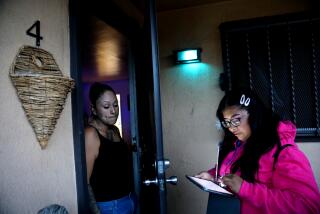L.A. County considers time limit on cash welfare aid
As welfare rolls grow, Los Angeles County officials are considering limits on how long some of the area’s most destitute residents can receive cash aid.
Supervisor Don Knabe is pushing a proposal to replace monthly general-relief grants with housing assistance for recipients who don’t try to find jobs or apply for disability benefits within a set time period. The goal, he said, would be to drop from the rolls people who are “just riding the system” so that funds are available to help those genuinely in need.
But some of his colleagues on the Board of Supervisors question whether recipients would be able to find housing they can afford with vouchers worth about $300 a month.
“The question is: Is there any there, there? Can the vouchers be redeemed?” Supervisor Mark Ridley-Thomas said. “There’s a lot more analysis that needs to be done.”
Supervisor Zev Yaroslavsky said the county should finish implementing a plan, approved at Knabe’s request more than a year ago, to begin shifting responsibility to the federal government for welfare recipients with permanent disabilities. Federal disability benefits are significantly higher than general relief.
“It’s a win for the county treasury, it’s a win for the people who are on these stipends … and it’s a win for the taxpayers,” Yaroslavsky said.
Knabe said the steps approved to date aren’t enough to offset the effects of persistent unemployment. The number of people receiving general relief in L.A. County has grown about 70% in the last three years, to more than 100,000 each month. By the end of the next fiscal year, the annual benefit costs are projected to hit $300 million.
General relief is intended as a short-term bridge for indigent adults who don’t get state or federal aid. In L.A. County, most recipients are single and get a monthly maximum of $221. County officials say about 60% are homeless, many with mental, physical or substance abuse issues that make it hard to navigate the welfare system or find jobs.
The restructuring plan focuses on getting beneficiaries into stable housing and helping them find work or apply for federal Supplemental Security Income and veterans’ benefits.
Irene Marquez, 59, has been on general relief for two years. She lost her job as a factory cleaner because she has memory loss from an inoperable brain tumor. She lives with a cousin in Boyle Heights, but fears she will be evicted because she can’t pay $300 a month in rent.
Recently, a county social worker told Marquez that instead of a couple hundred dollars, she could be getting up to $845 a month in Supplemental Security Income. Instead of relying on county emergency rooms, she could be covered by Medi-Cal.
“I didn’t know,” Marquez said. “I was so happy.”
The county is now introducing more rigorous screening to identify people like Marquez when they apply for general relief. Social workers help them through the difficult process of qualifying for federal aid. Registered nurses have been assigned to the county health, mental health and sheriff’s departments to retrieve records that might support such applications. If needed, a mental health evaluation is available and the county also plans to offer a medical evaluation.
The effort appears to be producing results. In the first seven months since the program was implemented in July, 14,038 people came off general relief and rejoined the workforce or were approved for federal benefits, said Phil Ansell, program and policy director for L.A. County’s Department of Public Social Services. In the same period in 2009-2010, 11,336 left the program.
However, Ansell said, the caseload has continued to grow “quite substantially.”
Those who are able to work are already limited to receiving benefits for nine of every 12 months and must participate in a job search program. Those deemed unemployable can stay on the program indefinitely.
About half of the county’s general-relief payments go to people who are not pursuing work or disability benefits, Knabe told the board last month. They include people who are over 60, pregnant, caring for a relative or suffering a temporary disability that does not qualify for federal aid.
“There has to be a more appropriate way to address this portion of the caseload,” Knabe said.
Advocates for replacing cash with housing aid cite San Francisco’s Care Not Cash program, which cut welfare checks for the homeless from about $420 to as little as $59 a month, instead offering permanent housing and support services. Since the program began in 2004, the number of homeless on that city’s welfare list has dropped from about 3,000 to 380 a month, said Trent Rhorer, executive director of the Human Services Agency.
Rhorer said it was not realistic to expect people without stable housing to hold down jobs, show up to appointments or complete the paperwork for federal aid.
“I think an investment in a housing voucher for a targeted population will result in that population getting off of public assistance,” said Rhorer, who has briefed L.A. County officials about San Francisco’s program. “The question is whether or not the county has the funds to finance it adequately.… The housing voucher has to mirror what the housing market is for this population.”
As many as half of those who left the program may have been living in neighboring counties and claiming benefits in San Francisco, Rhorer said. That may also be an issue in Los Angeles County but the numbers appear to be smaller, Ansell said.
Los Angeles County already gives some housing subsidies to homeless general-relief recipients who are looking for work or applying for federal aid. The recipients contribute $100 of each monthly grant toward their housing costs, with the county providing an additional $400 a month.
As of mid-February, there were 1,540 subsidies on offer. The county wants to increase the number to 10,000 by December 2014. Half the savings from Knabe’s latest proposals would go to the account that pays for the subsidies, with the rest going to the general fund.
If the county decides to replace some stipends with in-kind assistance, the benefit amount would probably increase to $297 a month because of state law, Ansell said. Recipients would be required to find their own housing, although the county may offer some emergency shelter beds or motel rooms for the time covered by the voucher, he said.
Advocates for the poor applaud the emphasis on ensuring that welfare recipients are housed, but worry about unintended consequences.
“Frankly, there aren’t a lot of places in Los Angeles County where you can find housing that is that affordable,” said John Maceri, executive director of Ocean Park Community Center in Santa Monica. He worries that recipients won’t be able to make up the difference, “just creating more homelessness.”
Many of those helped by St. Joseph Center in Venice use their cash aid for utilities, gas, bus fare and medicine, said the group’s executive director, Va Lecia Adams. She said the elimination of such funds could make them more vulnerable.
The Board of Supervisors has asked County Chief Executive William T Fujioka to come up with a plan by June to implement Knabe’s proposals. The supervisors have also asked him to include other recommendations to cut the cost of the general-relief program.
More to Read
Start your day right
Sign up for Essential California for news, features and recommendations from the L.A. Times and beyond in your inbox six days a week.
You may occasionally receive promotional content from the Los Angeles Times.






